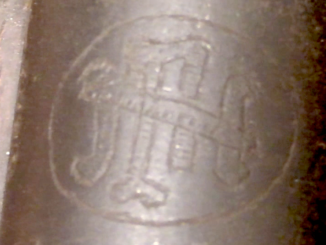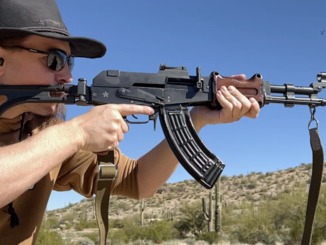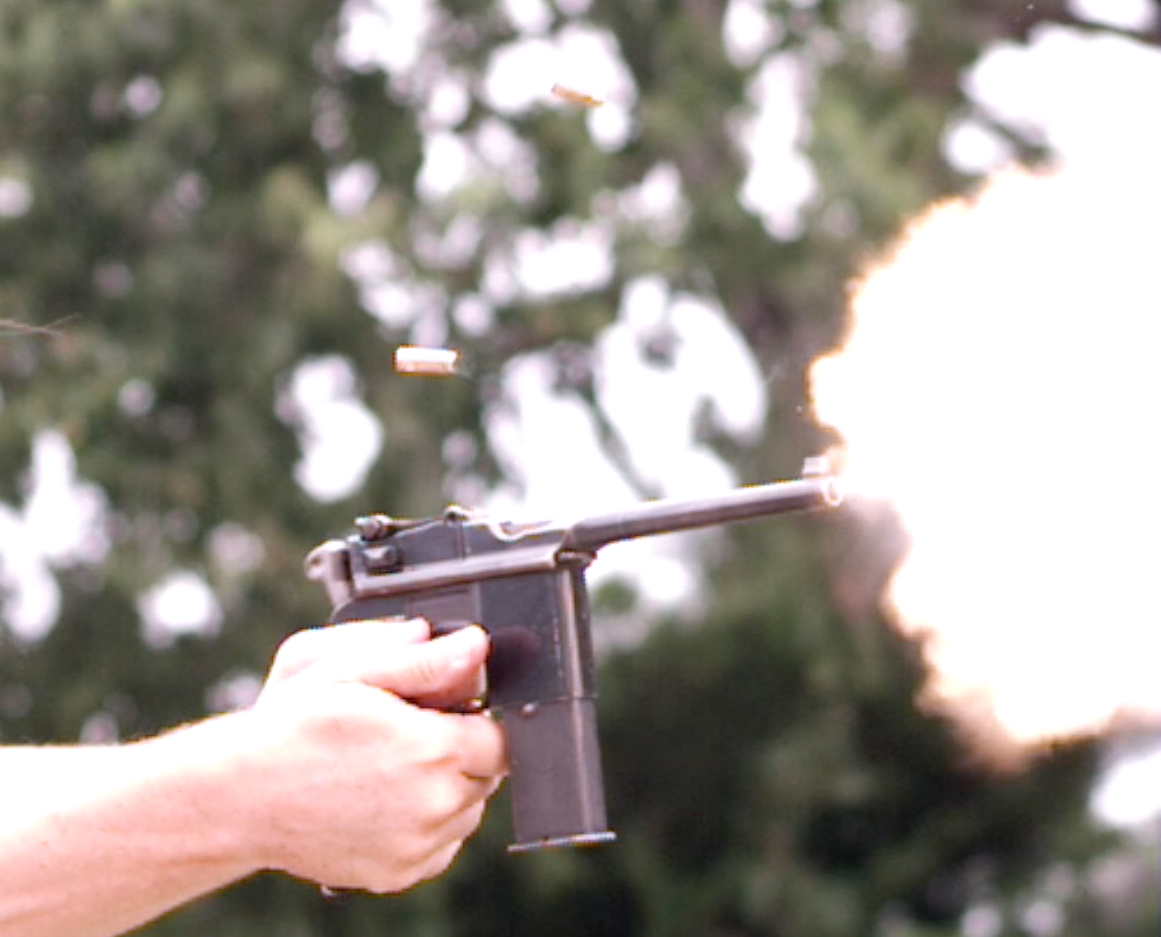One of the most common types of AK rifle in existence today is the Chinese Type 56 in its several variations, although very few of those rifles are in the United States in authentic full-auto form. This particular one was captured by a US soldier in the Vietnam War, who brought it back and registered it, making it a fully transferrable gun.
The Chinese received the technical package for the AK (and also the SKS, among other weapons) from the Soviet Union in the 1950s, as part of the USSR’s policy of providing military and technical aid to other nations sympathetic to the Communist cause (although a rift would grow between the USSR and China later). China would manufacture tens of millions of AK rifles, both of this milled receiver type (the Type 3 style) and the later stamped AKM pattern. The standard fixed-stock rifles like this one were fitted with under-folding spike bayonets. Folding stocked types were also made, both underfolding (Type 56-1) and side folding (Type 56-2). These weapons have become extremely prolific, and can be found in virtually any significant international conflict zone to this day.




Yeah sure, you fired full-auto because it was the “design intend”. Right got it.
and thank you for the video. top notch as usual.
PS: always shocking to see the vibrations of a rifle firing full auto. as if it will disintegrate the next second.
Every time when I see AK47 fired I realize that this is system which is at about maximum of its ballistic performance for its weight. You put there a tad bigger cartridge and it will be barely controllable and its utility greatly diminished.
Lot to the recoil impulse is due to piston size contribution. While AK’s piston diameter is 14mm, typical size of weapon’s piston firing SS109 shot is at 10mm. This represents area of about half size of AK piston. In addition, impulse of SS109 shot is about 60% of M43 shot. This gives you idea as to which of these two is easier to hold on target.
However, in overall ruggedness and (as pointed out) in no need for maintenance, the AK47 has an edge.
Yikes. If a much more powerful round were loaded I suppose that the AK would eventually suffer receiver wear and tear, so missing the target would be the least of your worries. What would happen if I were to subject a Type 56 AK to the stresses of firing 200 magazines of over-charged ammunition WITH NO PERIOD OF REST?
I once witnessed a man who wanted to “test” Type 56. He was of a lighter stature and went straight full auto. when I spotted that he’s leaning dangerously back, I swiftly jumped behind him and gave him support.
Anyway, milled piece is certainly better way to go, but Russians wanted to have cheaper (more volume suitable) version. In any case, those rivets must be well closed and thing is source of my admiration, although we have Finish version which is also out of shit-metal and does job quite well.
I believe Bulgarian Arsenal had returned to forged/ milled piece (and selling Stateside).
Hi, Denny :
When you say “shit metal” ( sheet metal ), I take it that you are referring to a stamped receiver AK variant of a Finnish AK, i.e., a Valmet M76, rather than the milled receiver Rk62, correct?
Yes, you are right Earl; you know how to read me. The folksy name for sheet metal is commonly used as I found some time ago, to my amusement naturally.
One thing you may want to hear Earl,
is that I had time ago chat with fellow (employed with Czech small arms industry in his past). He is the one I picked from the term “disassembled”. He told me that he has seen some fire-disassembled vz.58s during his carrier. This is not to say that 58 is in any way inferior to AK.
But, at the end anything can be wrecked, if there is enough dedication. nothing is forever – only diamonds.
Earl, Denny
Your comments reminded me of the legendary “shit shovel AK” – a guy with a parts kit and a D-handle scoop shovel – made a receiver out of the blade and used the handle for a buttstock! A classic example of why when our sanity is challenged us Texans say “Thank God for Vermont!”
http://www.northeastshooters.com/vbulletin/threads/179192-DIY-Shovel-AK-photo-tsunami-warning!
Hi Jim.
I think I have seen this prank before. We do not know what was durability of this contraption, but initial accuracy was impressive (that barrel is really oversized).
There is bunch of video on net with instructions how to make receiver for AK out of blanks/ flats. One fella was quite particular including heat treatment of rail portion after forming. There was a meticulous order of operations to be followed. Good to see that Americans can do this domestically and have vigour doing so.
If the gas tube gets hot, all that flexing could be hard on it.
Steel grade 4130/40 or equivalent, also known as “stress proof” as commonly used on barrels, actually picks somewhat strength as it gets to 200-250deg C. In any case this is always a bit of risky game as how far to go with it. But, I was not that lucky to see a ‘disassembled’ gun due to excessive heat input as yet.
This guy tried to disassemble an AK but it quit working when the barrel bent. https://www.youtube.com/watch?v=EwSJiAwoMpY
Oh yeah, same guy – Eric. I should have looked at this before posting his firs video. Yeah, I thing this guy has the dedication and most of all – balls of steel.
There is number of “AK destruction” videos on YouTube. One of my favoured is by this guy; he has the kind of dedication and humour mix I like:
https://www.youtube.com/watch?v=xlL-uRkJ0yA
It is worth of noting that the gun in test is of “sheet-metal” receiver construction and it is of WASR (Roumanian made) type, not necessarily the best one out there.
Oh yes, you can also have “all-American” AKs from Century Arms (eh-ehm), DDS (reportedly real good), already mentioned Bulgarian Arsenal made (probably best at the moment) and others.
Hi, Denny :
Please see the follow-up corrections to my comments to you regarding the “AK Meltdown : Reloaded” video by Iraqveteran88 with the MOLOT VEPR. My sincerest apologies to you and BP for any misunderstanding this might have caused. As I said to BP, I watched this video when it first came out and I forgot some of the details over time. I should have reviewed the video again before commenting.
You were looking at the first destruction test posted by Eric of Iraqveteran88 of a standard, low-end Romanian WASR-10. BP’s link ( https://www.youtube.com/watch?v=EwSJiAwoMpY )is also to Iraqveteran88’s website, but for a follow-up test called “Ultimate AK Meltdown : Reloaded” where he tested a high-end AK, namely a Russian MOLOT VEPR that dominated all other previous such tests he had done on any type of rifle.
At the end of the test, contrary to BP’s previous comment, the barrel was NOT bent. Instead, the charging handle had to be forced back to free up the gas piston because it was sticking in the gas tube, which had warped slightly from all that accumulated heat. What was amazing was that Eric simply looked along the barrel to figure out which way the gas tube was bent, then hit the barrel against the shooting bench to straighten out the gas tube, after which he proved the point by dumping a full 75-round drum on full-auto through the VEPR without a hiccup. He could probably have kept going from that point on with even more extended stress testing and the rifle would have kept on functioning, but I believe he ran out of ammunition.
No other rifle I can think of would be amenable to such a basic yet effective field solution to overheating damage and just keep right on going.
Per your observations, the very best AK’s available here in the U.S. would be the MOLOT VEPR, DDI and Bulgarian Arsenal guns.
I am posting this as a correction to my previous comments. BP was correct in saying that the barrel of the VEPR in Iraqveteran88’s had barrel droop from all the accumulated heat at the end of the test, which pulled the gas block and gas tube out of alignment and caused the piston to stick. It was not the gas tube itself that had warped. Eric struck the barrel against the shooting bench to straighten out the barrel and therefore pull the gas block and tube back into alignment. Other than that, I think the rest of what I said is still correct.
BP, my sincerest apologies for the misunderstanding on my part. I had watched the video when it first came out and I was going on memory alone which — as we all know — is quite fallible. I should have reviewed the video once more before posting.
Earl, you notes are well taken and I do not see why you need to apologise. We are in frendly, non-binding chat and hopefully lawyer do not reach us.
In terms of terminology (and I do not want to sound pedantic), what people call “gas tube” on AK is not exactly gas-tube but extended sheet-metal formed piston-cover which extends from real “gas-cylinder” into fore-guard.
And so, if this part was affected by heat (and no wonder it happened) if was easy to fix by properly aimed swat. Other than that, the AK (WASR 10) held very well.
I am almost tired of myself of promoting AK design, but if I should be indeed objective person, I have to continue doing it. While saying that, I am not a firm believer that AK is all but end of rifle design. It certainly is not and it will be one day relegated to history.
BP, please see my comments to Denny, especially the follow-up correction to my first comment. Sorry for the misunderstanding on my part and thanks in advance.
Not a problem at all. I believe most are here to learn, and that doesn’t happen without a few hiccups.
Mr. Cherndog. Forget overcharged rounds. If you start unloading AK magazines on full auto as fast as you can replace the magazine bad things will happen well before the 200 mark. At around six or seven magazines your front hand guard and forestock, which have been smoking since the third or fourth “magdump” will burst into flame, and if you keep shooting they will keep burning. Now the firearm will keep on functioning if you keep feeding it magazines while you, I don’t know, toast marshmallows? At around fifteen or so magazines the front of the receiver and the charging handle will be so hot that if you touch them while recharging you’ll get a second or third degree burn. And how do you change magazines without touching the receiver and/or charging handle? I suppose you could use a stick or somesuch, but we have progressed well past anything practical. And yes, given a pile of captured AKs and ammunition somebody tried it with the above results. It wasn’t me, I like my fingers too much, but I was there. FWIW, in the shoot ’em till they burn test (Using the term “test” very loosely.) it didn’t seem to matter if the receiver was milled or stamped. Oh, and a piece of nickle knowledge; If you do get your AK that hot and you decide to throw it into water to cool it off, throw the whole thing in all at once. If you try to sort of ease it in you can warp the thing like a Katana, which is fine for Japanese swords but is pretty much the end of life for a select fire carbine.
Wafa Wafa, Wasara Wasara.
Um, it would literally burst into flames before you got through 10% of the magazines. BTDT. LOL
Not really.
https://en.wikipedia.org/wiki/Zastava_M76
https://en.wikipedia.org/wiki/Zastava_M77
That thing his heavy like pig. At 4.6 and 4.8 kg… gime a break. When I pick vz.52 (4kg) I think is heavy; that is actually feather weight in comparison.
Better to compare M77 with anothe model of machine rifle
Point was that AK in larger cals is perfectly doable.
Both use standardized receivers with M70 series, only lengthened to accept longer rounds. Zastava learned about making universal “family” of weapons from hiring Stoner as a consultant in late 1960s…
Weight wise they compare to G3 and FAL with same features (scope, bipod, heavy barrel).
Well yes, Zastava proved that. But also the weight is up from 3 and something to around 4.5kg. Also, the guns you mentioned are primarily self-loading ones in their prime purpose. Not an assault type of rifle.
Valmet also made the M88 Hunter (called “Petra” in Finland), which was chambered for .30-06, among others (.308 Winchester etc.). The Hunter, like the name suggests, was a pure civilian semi-auto rifle, but mechanically it was a pure AK and even looked like one aside from the sporter style stock.
I recall seeing Petra. It had wooden stock of commercial appearance and probably corresponding quality. Finish was pretty good, but I do not remember the weight. Semi-auto only of course.
You are quite right. MOLOT of Russia offers the VEPR AK in 7.62mm x 54R, and it is an outstanding rifle with an enviable reliability and performance record. The point is that as long as the increase in mechanical and structural stresses are properly compensated for with properly-integrated design modifications and / or a basically over-engineered parent platform to begin with, there should be few, if any, issues with handling a more powerful caliber. The trade-off is usually a weight increase, but with careful engineering this can be kept within reasonable limits.
Just looking at M76 – it has been built (in license?) in North Korea. I suppose NK would change calibre to 7.62x54R; just guess.
I am not sure about that, no info of Zastava selling a licence of know-how to NK ever. They sold M76 to Iraq with full manufacturing line (also for M70s, made in Iraq as Tabuk).
Also M77 was sold to Cyprus, Sudan and Chad. On Cyprus they liked them much more then FALs.
I am aware they do well in Mid-Easter and N.African areas. Did they not also sell to Algeria?
@ Jim In Houston :
Thanks very much for sharing that terrific article. “Boris” certainly did a great improvised build that makes a mockery of gun snobs who spend ten times or more on less durable and much fancier high-end hardware. I especially liked the photo comparison pointedly illustrating what happens with the T7075 forged aluminum Mil-Spec receiver of the M-16/AR-15 ( catastrophic, literally shattering, non-repairable failure ) and the steel AK receiver ( bent but easily straightened ) when subjected to excessive compression forces. Aluminum, magnesium and other lightweight metal alloys with high strength-to-weight ratios certainly have their rightful and 100% functional place in modern firearms design, but for me there is still nothing quite like the sheer durability and metallurgical versatility of good gun steel.
I’m sceptical of the commonly-quoted figures for Type 56 Assault Rifke production of 10 million or tens of millions. I don’t believe the it was ever the PLA’s primary infantry weapon, which was the SKS (Type 56 Carbine in China) until it was replacd by the Type 81. Also I don’t believe the PLA ever had more than about 2 million personnel.